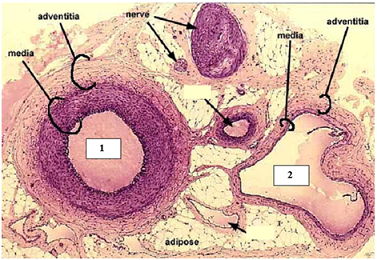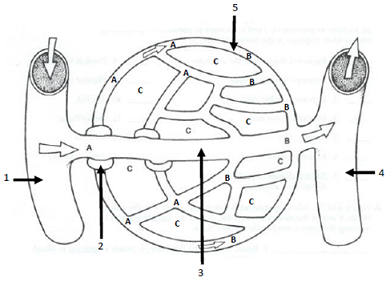Assignment -
Activity 2 - Blood Vessels Structure
Q1. Use the following terms to match to the blood vessel descriptions given below. Terms may be used more than once.
A. arterioles
B. capillaries
C. continuous
D. elastic arteries
E. fenestrated
F. metarteriole
G. muscular arteries
H. postcapillary venule
I. precapillary sphincters
J. sinusoids
K. thoroughfare channel
L. veins
M. venous sinuses
1. Lumen is the size of a red blood cell
2. Carry blood under the highest pressure
3. Smallest veins that drain capillaries
4. Capillaries with large intercellular clefts
5. Contain valves
6. Distribute blood to various organs as it moves away from the heart
7. Structures that control blood flow into capillary beds
8. Veins with only a tunica interna; supported by surrounding tissues
9. Largest diameter arteries, low resistance vessels
10. Capillary type with uninterrupted lining
11. Arteries with thickest tunica media
12. Carry blood under lowest pressure
13. Vessels important in controlling blood pressure
14. Distal end of a metarteriole that carries blood into a venule
15. Capillary type with numerous pores
16. Considered blood reservoirs
Q2. Use the photomicrograph below to answer the following questions.

The structures labeled 1 and 2 are blood vessels.
a) Which of these is a vein and which is an artery?
b) Provide two reasons for your answer to a. (Complete sentences please).
Activity 5 -
This activity involves a concept map on factors affecting blood pressure. Students are asked to drag a series of factors to boxes on the map in such a way as to demonstrate relationships between them.
Note: in order to move the terms you may need to click on "ENABLE EDITING" BOX at the top.
Do NOT use slide show mode to do this activity.
Activity 6 - Blood Pressure Regulation
Answer the following questions -
Q1. A blow to the base of the skull has sent an accident victim to the emergency room. There are no signs of hemorrhage, either internally or externally, yet his blood pressure is critically low. What is the probable cause of his hypotension? (Think about where the injury has occurred.)
Q2. Mr. Grimaldi has been diagnosed with a posterior pituitary tumor that is secreting excessive amounts of ADH. Would you expect this patient's blood pressure to be chronically elevated or depressed?
Describe two ways in which the ADH is affecting his blood pressure.
Q3. Renal (kidney) disease in a young woman has resulted in blockage of the smaller arteries within the kidneys. Although her urine production is normal (i.e., she is not retaining fluid), she has become hypertensive.
Why has this problem with her kidneys led to hypertension (i.e., what is the mechanism at work)?
Would this be a case of primary or secondary hypertension? Explain.
Q4. A man in his 40s was diagnosed with hypertension. Dietary changes and exercise have helped, but his blood pressure is still too high. His doctor originally prescribed a diuretic to treat his condition, but now has switched him to an ACE inhibitor.
Explain how each of these types of medication would help to treat his hypertension.
Q5. Ms. Connors has just had a right femoral arterial graft and is resting quietly. Orders are given to palpate her popliteal and dorsalis pedis pulses and to assess the color and temperature of her right leg four times daily.
Why were these two particular blood vessels selected to be monitored?
Why were each of these specific orders given (pulse, color, and temperature)? (What might you anticipate if there was a problem).
Activity 8 - Capillary Dynamics
Use the capillary dynamics diagram to answer the following questions -

Q1. Match the following structures to the numbers on the diagram: arteriole, precapillary sphincter, true capillary, vascular shunt, venule
1.
2.
3.
4.
5.
Q2. List the 4 pressures at work in capillary beds that determine bulk flow.
With each pressure, indicate whether it works to move fluid into or out of the capillary.
Q3. Under normal conditions, in which area does blood hydrostatic pressure dominate, A, B or C?
Q4. Under normal conditions, in which area does blood osmotic pressure dominate, A, B or C?
Q5. Which specific pressure causes fluid to flow from A to B?
Q6. Which specific pressure causes fluid to move from A to C?
Q7. Which specific pressure causes fluid to move from C to B?
Q8. What is responsible for osmotic pressure inside the capillary?
Q9. If excess fluid does not return to the capillary, where does it go?
Attachment:- Assignment Files.rar